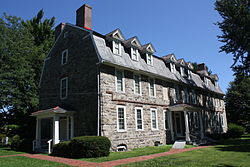Kurs:Linguistic Postcolonial Studies. A modular introduction based on Moravian mission narratives
- What
- Asynchronous self-study course on the language and cultural history of the Moravian mission.
- Media used
- Audio and video files integrated into 3D-models of historical buildings
- Who for
- Students of German linguistics as well as interested laypersons
- By whom
- Robert C. Schuppe (research assistant at the Chair of German linguistics and language history at TU Dresden), developed as part of the joint project virTUos, funded by the Stiftung Innovation in der Hochschullehre.
- Documentation of the development process (German)
The self-study module allows you to familiarize yourself with the fascinating linguistic and cultural history of the Moravian mission at your own pace and according to your own interests. This pietistic religious community was founded in 1727 in East Saxony and soon established mission stations in places such as Greenland, South Africa, the later USA and many more. This course covers the history of the Moravians, their mission in North America, and their documentation of Native American languages. Based on high-quality 3D-scans of historical buildings, completing the module becomes an immersive experience.
Structure
BearbeitenThe module consists of two 3D-models of historical buildings in North America. Each of these models is enriched with multimedia content that can be viewed and listened to in any order.
Course objectives
Bearbeiten- Participants receive an overview on the missionary activity and language description of the Moravian Church in the 18th and 19th centuries
- Participants will be made aware of the cultural-historical significance of publications from the Moravian context, thereby arousing interest in the subject area
- Potential for their own research work is demonstrated
